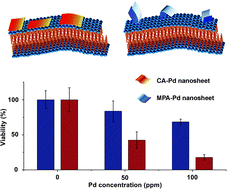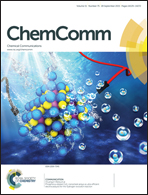Functionalized ultrathin palladium nanosheets as patches for HepG2 cancer cells†
Abstract
Flexible, charged Pd nanosheets were prepared by using short chain thiolated carboxylic acids and amines. They could wrap around amine or hydroxyl functionalized micron-sized spheres driven by electrostatic interactions. Upon incubation with HepG2 cells, the positively charged cysteamine (CA) functionalized Pd nanosheets exhibited a much higher cytotoxicity, showing more than 80% cell death at 100 ppm than the negatively charged 3-mercaptopropionic acid (MPA) functionalized ones which caused 30% cell death. The results show through surface functionalization Pd nanosheets can be modified to interact differently with HepG2 cancerous cells, resulting in varied cytotoxicity.


 Please wait while we load your content...
Please wait while we load your content...